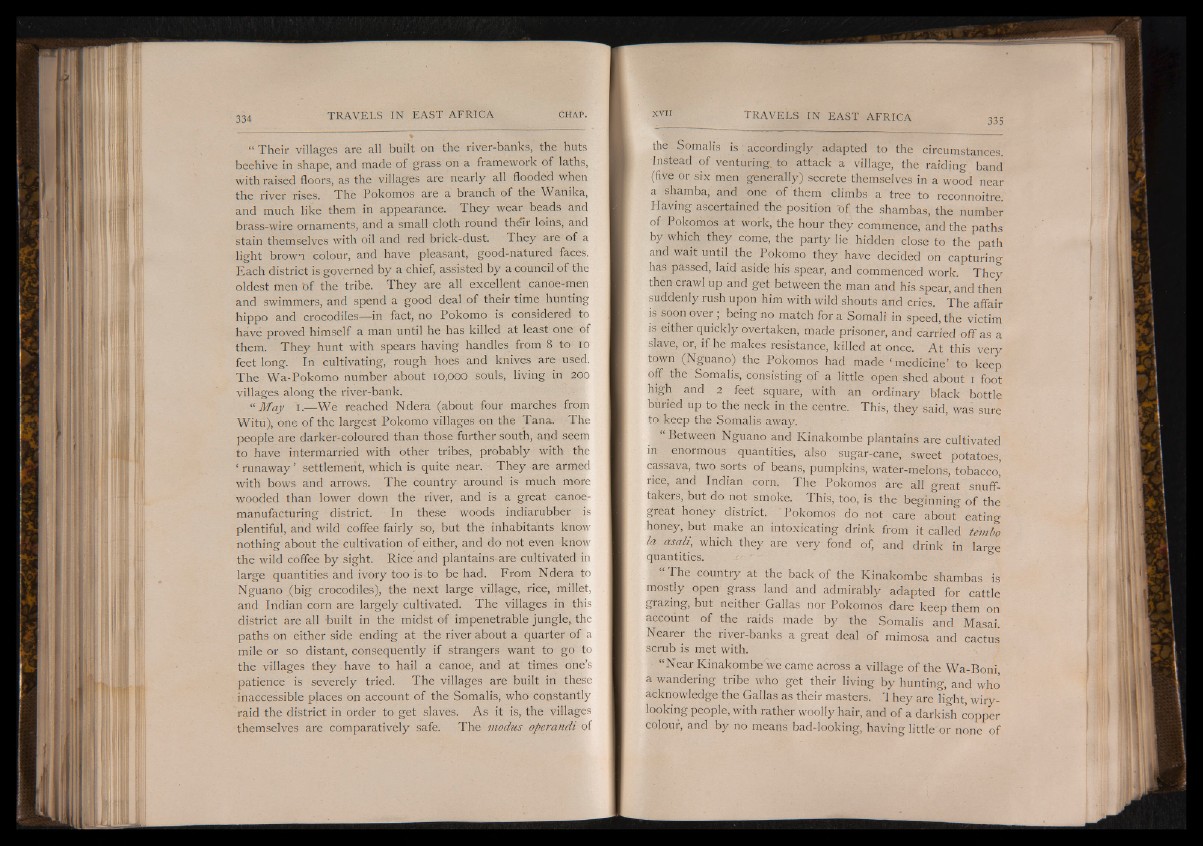
“ Their villages are all built on the river-banks, the huts
beehive in shape, and made of grass on a framework of laths,
with raised floors, as the villages are nearly all flooded when
the river rises. The Pokomos are a branch of the Wanika,
and much like them in appearance. They wear beads and
brass-wire ornaments, and a small cloth round their loins, and
stain themselves with oil and red brick-dust. They are of a
light brown colour, and have pleasant, good-natured faces.
Each district is governed by a chief, assisted by a council of the
oldest men of the tribe. They are all excellent canoe-men
and swimmers, and spend a good deal of their time hunting
hippo and crocodiles—-in fact, no Pokomo is considered to
have proved himself a man until he has killed at least one of
them. They hunt with spears having handles from 8 to 10
feet long. In cultivating, rough hoes and knives are used.
The Wa-Pokomo number about 10,000 souls, living in 200
villages along the river-bank.
“ May I — We reached Ndera (about four marches from
Witu), one of the largest Pokomo villages on the Tana. The
people are darker-coloured than those further south, and seem
to have intermarried with other tribes, probably with the
‘ runaway ’ settlement, which is quite near. They are armed
with bows and arrows. The country around is much more
wooded than lower down the river, and is a great canoe-
manufacturing district. In these woods indiarubber /is
plentiful, and wild coffee fairly so, but the inhabitants know
nothing about the cultivation of either, and do not even know
the wild coffee by sight. Rice and plantains- are cultivated in
large quantities and ivory too is-to be had. From Ndera to
Nguano (big crocodiles), the next large village, rice, millet,
and Indian corn are largely cultivated. The villages in this
district are all built in the midst of impenetrable jungle, the
paths on either side ending at the river about a quarter of a
mile or so distant, consequently if strangers want to go to
the villages they have to hail a canoe, and at times one’s
patience is severely tried. The villages are built in these
inaccessible places on account of the Somalis, who constantly
raid the district in order to get slaves. As it is, the villages
themselves are comparatively safe. The modus operandi of
the Somalis is accordingly adapted to the circumstances.
Instead of venturing, to attack a village, the raiding band
(five or six men generally) secrete themselves in a wood near
a shamba, and one of them climbs a tree to reconnoitre.
Having ascertained the position ~of the shambas, the number
of Pokomos at work, the hour they commence, and the paths
by which they come, the party lie hidden close to the path
and wait until the Pokomo they have decided on capturing
has passed, laid aside his spear, and commenced work. They
then crawl up and get between the man and his spear, and then
suddenly rush upon him with wild shouts and cries. The affair
is soon over; being no match for a Somali in speed, the victim
is either quickly overtaken, made prisoner, and carried off as a
slave, or, if he makes resistance, killed at once. A t this very
town (Nguano) the Pokomos had made ‘ medicine’ to keep
off the Somalis, consisting of a little open shed about i foot
high and 2 feet square, with an ordinary black bottle
buried up to the neck in the centre. This, they said, was sure
to keep the Somalis away.
“ Between Nguano and Kinakombe plantains are cultivated
in enormous quantities, also sugar-cane, sweet potatoes,
cassava, two sorts of beans, pumpkins, water-melons, tobacco,'
rice, and Indian corn. The Pokomos are all great snuff-
takers, but do not smoke. This, too, is the beginning of the
great honey district. Pokomos do not care about eating
honey, but make an intoxicating drink from it called tembo
la asalz, which they are very fond of, and drink in large
quantities.
I The country at the back of the Kinakombe shambas is
mostly open grass land and admirably adapted for cattle
grazing, but neither Gallas nor Pokomos dare keep them on
account of the raids made by the Somalis and Masai.
Nearer the river-banks a great deal of mimosa and cactus
scrub is met with.
“Near Kinakombe we came across a village of the Wa-Boni,
a wandering tribe who get their living by hunting, and who
acknowledge the Gallas as their masters. '1 hey are light, wiry-
looking people, with rather woolly hair, and of a darkish copper
colour, and by no means bad-looking, having little or none of